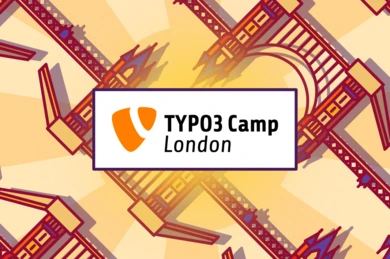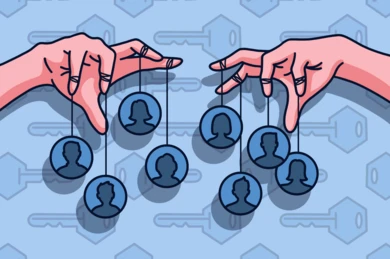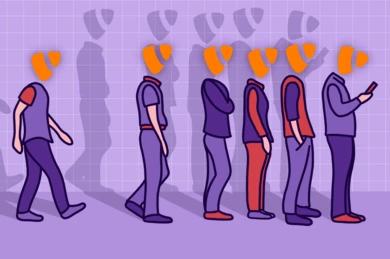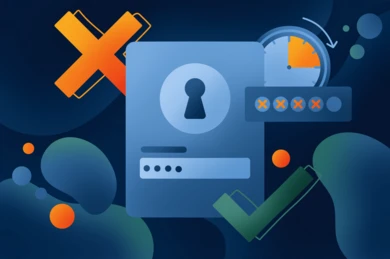
T3CON25 showcased the future of TYPO3 with insights on TYPO3 v14, AI, digital sovereignty, and open-source solutions driving secure, modern web experiences.
Sharing what we've learned while delivering client projects online for more than 20 years and being leading contributors to TYPO3 is part of who we are.
We choose widely-adopted open-source technologies because we can fix, extend, and improve them while building on the experience and support of thousands of our peers. In our blog, we share with you the knowledge we've gained along the way for you to build on.
Read on!


T3CON25 showcased the future of TYPO3 with insights on TYPO3 v14, AI, digital sovereignty, and open-source solutions driving secure, modern web experiences.

Five days, 14 contributors, countless ideas — and 55 patches created! Our team at b13 joined the TYPO3 v14 Feature Sprint in Geneva to push key improvements for backend UX, APIs, and media management.

Subdirectories, Subdomains, and Better SEO Rankings. The answer to which one should I use? is always it depends. Subdomains and subdirectories interact differently with SEO rankings, regionally-specific top-level domains, and your internal site organization and maintenance.

TYPO3 is still an underdog in the UK. The first TYPO3 Camp in London demonstrated the powerful interplay between community, knowledge, and open source — and why visibility is the key to growth.

Solve TYPO3 user management bottlenecks with Managing Editor. Give editorial teams user creation powers without admin access. Secure, controlled, efficient.

This blog post explains the concept of the "overlays" mechanism in TYPO3, with some in-depth insights on how the TYPO3 Core Engine deals with this feature under the hood.

TYPO3 simplifies working with country lists by including a comprehensive Country API out-of-the-box, sourced from authoritative UN data. Say goodbye to third-party extensions and enjoy up-to-date, localized country lists in any language.

Explore our comprehensive guide on managing redirects and page movements in TYPO3. Learn how to maintain SEO and enhance user experience with seamless navigation adjustment.

Discover how to efficiently tackle duplicate content in TYPO3 with our expert guide. Learn about unique strategies and essential tools to boost your site's SEO today.

Discover 3 easy ways to check your TYPO3 version and learn the next steps to keep your site secure and up-to-date. Stay informed with our helpful guide.

TYPO3 v12 introduces better support for languages and locales, including BCP 47 format, automatic fallbacks, and reduced configuration overhead for setting up new languages.

When built-in message transports hit their limits, RabbitMQ can provide TYPO3 with a scalable, robust message queue.

Discover the significance of trailing slashes in URLs and how they impact SEO and user experience. Learn best practices and TYPO3 solutions with b13's expert guide.

You’re invited: TYPO3 has a new home for its system configuration in TYPO3 v12. In our latest post we’ll walk you through the new changes, their advantages, and how it fits into TYPO3’s system history.

The Core Web Vitals are the go-to metrics for determining if a web page responds to user interaction swiftly and without disruptions. TYPO3 admins and developers need to know how these metrics work.

Find out how Content Security Policy can protect your websites from malicious attacks. Cross-Site Scripting exploits vulnerabilities in CMS architecture—but with the right security policy, you can keep your websites safe.

Unlock TYPO3 v12's enhanced TCA types. Improvements to the Table Configuration Array introduce streamlined code and simply work for integrators and extension authors.

Choosing an agency is difficult, but once you’ve gone through your project’s concept document, and gained an understanding of your agency’s technical expertise and proposals, the process becomes more straightforward. At that point, you’ve kicked off your partnership and are looking forward to shared success. Before getting too deep into the details, however, you should have a work plan for what gets tackled first. And while it's natural to get caught up in the excitement of a new project, a thorough agency will take care of the basics first: important housework tends to be critical to the success of any project.

Whether you’re launching a brand new project or upgrading your decades-old multisite website, you need to make sure your agency fully understands your project goals and your current suite of technology. In our recent post, “How we kick off TYPO3 projects for enterprises,” we explained why you should expect a Concept Document before your agency begins writing a single line of code. But say your agency has come to you with a set of suggestions for your CMS, integrations, and extensions—at that point, an obvious question comes up: how do I know that this is the right technology?

TYPO3 is an open source CMS used widely across Europe, but it is still surprisingly little known in some regions. Built for international, multiregional, distributed, and multilingual organizations, TYPO3 is an accessible CMS for users around the world. In this article, we’ll walk you through the strengths of this CMS and why you should consider it alongside other popular solutions like Sitecore, Drupal, and WordPress.

While external teams will upgrade your ability to make updates and extend functionality for your customers, integrating them effectively is a challenge because code can quickly become opaque, buggy, and brittle. Our standard processes leverage automation, version control tools, virtualization, and standardized best practices to make sure everyone not only tugs on the same rope, but – crucially – in the same direction.

In an ever-evolving technological landscape, keeping your brand and technology up-to-date and competitive can feel like a full-time job. Whether you’re working on a website relaunch, a brand refresh, or a system-wide version update, it’s going to be time-consuming and expensive, not to mention repetitive. When your focus turns instead to future-proofing your website, you ensure your design and technology are ready for anything, now and for the long-term.

Enterprises now have many software delivery channel options to choose from. With software-as-a-service (SaaS) and cloud-based implementation models on the rise, you might be trying to figure out the best software delivery channel to support your enterprise’s digital strategy. If you don’t have an internal IT department, SaaS can be tempting, but when you also have stringent data compliance needs, an on-premises (or on-prem for short) solution is your best bet.

TYPO3’s separation of content and code is one of its major strengths. TYPO3 saves content in containers called content elements, which you can stack in content areas on a page record to create pages. The different parts of this highly configurable setup include “page types” (defined by the “doktype” field value in the pages database table record), a “backend layout” configuration, and possibly a third, separate “frontend layout” configuration value. We combine these components in various ways to enable different scenarios and desired outcomes.

In previous installments of our TYPO3 v11 series, we covered some of the great UX improvements that are making editors' lives easier. In this final post of the series, we’ve got something special for all the developers and site administrators: new TCA types. Using these dedicated types will reduce and simplify the TCA configuration required for special fields. They also allow auto-configuration and auto-creation of database fields.

TYPO3’s “Form” system extension is a flexible framework that can handle many configurations, templates, and use cases. While TYPO3 makes it easy to create forms on the fly, your business may have more complex needs that require backend adjustments. Rather than seeking tech help for every minor change, your company might benefit from a custom extension or flexible finisher that makes forms more self-serviceable for marketers. At b13, we love to help our clients get more flexibility out of TYPO3 Forms with custom solutions for specific business needs.

At b13, we’re often approached by CMOs and CEOs disgruntled by escalating costs. What seems like a relatively “cheap” CMS or software solution can often come with hidden or long-term expenses—like multiple relaunches, jumps in licensing fees, or pricey additions. As an agency committed to free and open source software like TYPO3, we’re dedicated to helping companies make forward-thinking decisions for their content strategy. In the process, we’ve identified some best practices for making smart, cost-effective decisions for your CMS.

We have the experience to accommodate complex or atypical multilingual use cases with TYPO3’s powerful language capabilities

Some initial planning can make localization much simpler. Here’s how we help our clients set up their workflows for smooth, efficient translations in TYPO3.

In TYPO3, language configuration and translation comes easy and out of the box. b13 is constantly improving the TYPO3 Core localization features to respond to real users’ needs

Use extensions for easier upgrades, maintenance, and a boost in functionality.

Before you buy more server space to speed up a slow-loading TYPO3 site, there might be another solution. Transitioning from TYPO3’s native menu to b13’s menus extension can significantly improve your site’s loading speed and allow more simultaneous users, while reducing the load on your servers.

Previously in this series, we covered the improvements TYPO3 v11 brought to the Page Tree in the post, Resizable Navigation Area in TYPO3. There is one feature in particular that deserves its own shiny spot in our list of new features in TYPO3 v11, and that is the tree functionality within the Element Browser and the Link Picker.

One of TYPO3's powerful features for content publishing is Workspaces - creating and staging in a draft environment before publishing content. TYPO3 v11 adds a few important touches to this functionality, making it even more powerful - for both developers and editors.

TYPO3 version 11 supports keyboard navigation as suggested by the ARIA Authoring Practices. Users don’t need a mouse to navigate menus, trees, and to select multiple records. This work flows through to benefit all backend users, whether they’re solely relying on the keyboard, a screen reader or other assistive technologies.

Working with multiple records just got easier. Copy, edit and delete multiple files at once with this improved feature in v11.

We show you how to use the new Show Columns Selector in TYPO3 v11 so you can manage large sites with hundreds of pages, records and assets with ease.

We talk about the rate limiting feature in TYPO3 v11 and the flexibility it offers for configuring backend login restrictions.

The Page Tree is one of the key concepts of TYPO3. In v11 it’s now easier than ever to adjust it just how you like it.

TYPO3 v11 gave the command line interface a boost with new commands. We show you the benefits to installations running in Composer mode.

Some organizations need multi-tree installations for their different translated content. We’re proposing an open source solution that you can be a part of.

Forms are a must-have on any website these days; from a simple contact form to a complex multi-page form for data processing. TYPO3 CMS's built-in form functionality has all the answers.

TYPO3 makes it easy to create sites that rank well with robust SEO features

Meet the improved Folder Tree in TYPO3’s File List module, way faster than before. Plus: Now including a filter!

The new multi-factor authentication feature is shipped with the latest version of TYPO3. Here’s an overview of what’s included.

Make your job easier with a customized TYPO3 backend. As of v9, you can create a great working environment for your editors.

TYPO3 made some important updates to site handling in v9 and v10. We wrote an explainer on new changes, including slug naming and automatic redirects.

Benni explains the different caches in TYPO3 and what they do. All about the Caching Framework.

b13’s newest addition, Oli Bartsch, tells us how he got started in TYPO3 and about his Core contributions.

If you need to publish or update content in multiple languages at the same time, or involve others to sign off or edit content before publishing, then content staging is the solution you’re looking for. Did you know TYPO3 solves this out of the box with the Workspaces module?

Today’s world is global, and content distribution networks (CDNs) bring content closer to users around the world for lightning-fast performance wherever they are. TYPO3 is ideally adapted to modern CDN technology, reducing the load on your server, and even taking caching off your to-do list!

Meet our newest team member and bug-fixer-in-chief for TYPO3 Workspaces.

These changes keep TYPO3 awesome. They’re worth the effort it takes to adapt!

Workspaces are a killer feature in TYPO3 and we’re helping it reach its full potential. Find out how you can help or support us!

How to add complex page layout substructures using the TYPO3 Container Extension. Part 3 of our series.

How to extend TYPO3's built-in layouts with a simple 2-column element using the Container Extension. Part 2 of our series.

Extend TYPO3's built-in layout concepts with the Container Extension. Simple flexibility for editors, reduced risk for future upgrades.

Dive deep into how TYPO3 is caching variants of a page and how to improve caching - but also how you can leverage TYPO3’s Site Handling into speaking URLs.

Well-structured backend user experiences are critical to successful TYPO3-projects. Learn how to keep your editors happy day in and day out.

Learn about using middleware in TYPO3 to implement custom access rules. Includes two real-world examples, along with code and tips.

Our TYPO3 caching blog series is ideal for developers familiar with TYPO3 who want to fully understand the core concepts and build robust and faster websites with TYPO3.